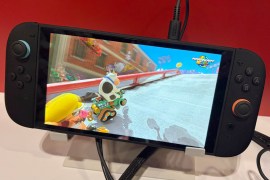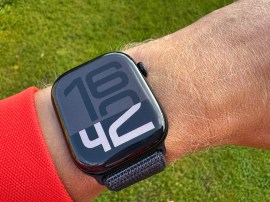Samsung Odyssey Ark (2023) hands-on review: I get it now
Versatile mega-screen makes much more sense with multiple inputs

If bigger is better, last year’s Samsung Odyssey Ark had a strong claim to being the best gaming monitor in the world. Sitting in front of the 55in curved behemoth was a jaw-dropping experience, whether in landscape or rotated into its towering portrait mode. But things aren’t that simple. While it promised perfect productivity, the fact it could only show a single external input at once meant we couldn’t recommend it for anyone rocking a multi-monitor setup.
Samsung has taken that feedback on board for this latest G97NC revision, which is set to go on sale towards the end of 2023. It’ll let you see four devices at once in landscape (three in portrait), and even comes with a KVM switch built in to cut down on cable clutter. We got the chance to try it out at Gamescom, to see if it’s the ultimate desktop upgrade for gamers, streamers and even home workers.
Design & build: still a beast



The new Odyssey Ark doesn’t look any different from the old one (which remains on sale, for considerably less than launch price, at the links below) – but that’s no bad thing. It was already a stunning slab of glass and metal, with a 1000R curve that enveloped your peripheral vision from desktop distance. The bezels are as skinny as you’d expect for a flagship monitor, and while it’s not as svelte as an OLED display, it still looks impressively slim from the sides.
Installing one definitely looks like a two-man job, with the weighty stand taking up a considerable amount of desk space. It has to be, given how top heavy the thing must be when tilted into portrait mode. Rotating the panel is still done by hand, rather than electronically, but the mechanism is smooth and light enough that doing so was a breeze.
There was plenty of tilt available, and a huge amount of height adjustment. You might have to crane your neck to see the far corners, though.
The flat black finish gives the back of the screen a monolithic appearance, and would look rather tasty if your desk faces out into the middle of the room, rather than towards a wall. That said, the RGB LED strips will do a better job of adding ambient light to your setup with something to bounce off.
Features & interface: taught by TVs



Physical upgrades are largely kept to the OneConnect box. This sends mains power and all your inputs to the screen through a single cable, which is much easier to keep hidden from view than the jumble of cables going into the box itself. We didn’t get to see it up close during our demo session, but imagine it’ll look almost identical to the old one – apart from the newly added DisplayPort connection, that is.
It still has wired and wireless internet baked in, along with three HDMI 2.1 ports and a scattering of USBs, which can act as a KVM switch when hooked up to two separate computers.
You still get a pair of remote controls. The Ark Dial rotary controller lives on your desk, for making quick tweaks. It keeps itself charged up with a small solar panel. The other looks like a traditional TV remote, with just a handful of buttons and shortcuts to big-name streaming services like Prime Video, Disney+ and Netflix. The Odyssey Ark runs a slightly tweaked version of Samsung’s Tizen smart TV interface, which felt perfectly speedy to scroll through.
It’s multitasking where the 2023 version of the Ark really comes alive. Previously you could split the 55in screen into four virtual ones in landscape orientation, or three in portrait – but only one of them could be from an external input, with the others restricted to Tizen apps like the web browser or smart TV services. Now you can show multiple inputs at once, which is a huge boon for anyone that currently uses two or more separate monitors.
It works as smoothly as you’d hope, with picture-by-picture just a few clicks of the remote away. On the old Ark we found that multiview mode limited refresh rate and resolution, so we’ll have to wait until a full review to see if that’s also the case here.
Happily the aspect ratio and screen size options return, so you can play in a more cinematic 21:9 aspect ratio or shrink the playable area to something resembling a 27in screen – something dedicated esports players should appreciate.
Picture quality: impressive again


According to Samsung, the Ark’s 55in curved panel is unchanged from the first-gen model – which means everything we said about it in our review late last year should also apply here. The mini-LED backlighting still has more than 1000 dimming zones, for exceptionally good black levels and killer contrast. It won’t outpace a similar-sized OLED, but then it’s not like there are any out there that are anywhere near as multi-purpose as this.
Esports pros might turn their noses up at the 165Hz refresh rate, but it’s ample for anyone that isn’t getting paid a wage to play games. AMD Freesync Premium Pro should all but guarantee there’s no screen tearing, even if your graphics card is working overtime to render everything at the Ark’s native 4K resolution. Samsung also claims 1ms response times, although we’re yet to test it.
We remain impressed by the Odyssey Ark’s audio, too. Four drivers and two woofers deliver plenty of bass and a detailed mid-range for built-in speakers, based on what we heard on the Gamescom show floor. With such a big panel there’s simply more space inside for the drivers, so it should comfortably outshout any smaller gaming monitor.
Samsung Odyssey Ark (2023) initial verdict
The second-gen version of Samsung’s gloriously OTT gaming monitor appears to, on first inspection at least, fulfil the promise made by the original Odyssey Ark. All that display real estate finally makes sense now you’re able to show multiple inputs on it at once, and the KVM switch can simplify your setup even further.
It sticks with mini-LED panel tech, which still plays second fiddle to OLED in terms of black levels and contrast, and it’s still a seriously pricey bit of kit. But as showpiece hardware goes, it’s hard to imagine any other screen having quite so much wow factor.




